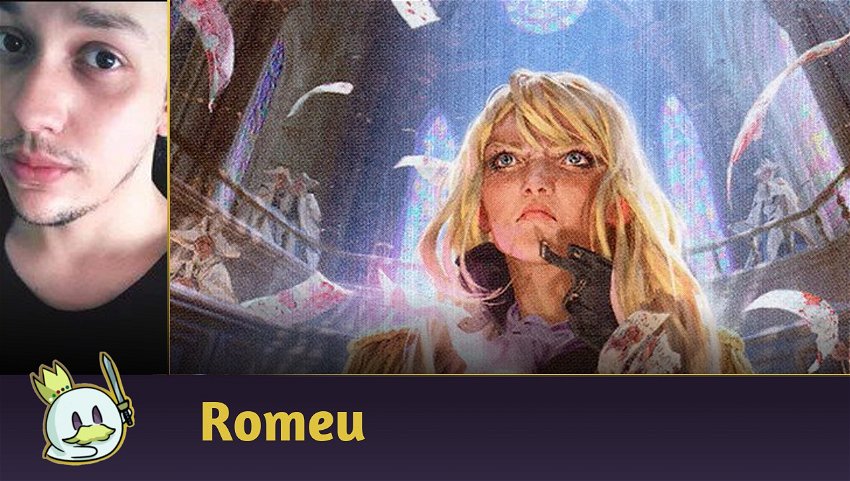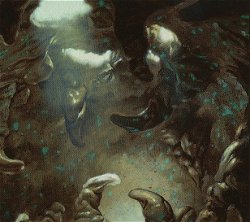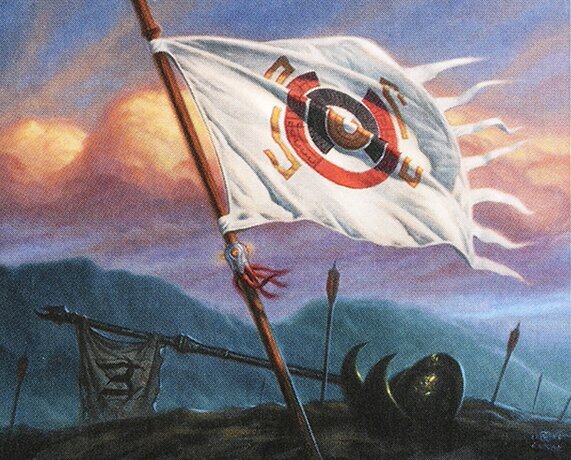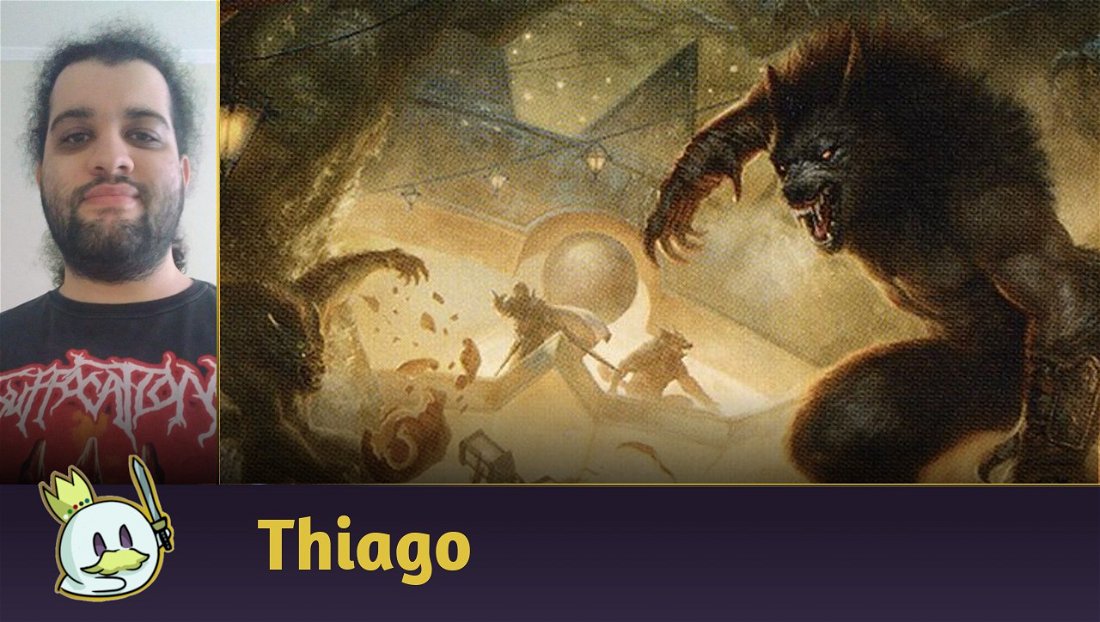Innistrad: Crimson Vow has barely launched on Tabletop, but is already demonstrating its potential for competitive formats on Magic Online and Magic Arena.
And although we've seen several cards from the new set in the Top 8 of this weekend's Pioneer Challenge, like Edgar, Charmed Groom on Vampires and Flame-Blessed Bolt on Izzet Phoenix, the deck that really highlighted this week, with two copies, was Selesnya Humans, so I've decided that I'll be analyzing this archetype today.
The Deck
Ad
There's a saying mentioned by our other writer, Thiago (NileDeath), that any tribal with a Collected Company playset becomes a potential threat, and I couldn't agree more with him.

After all, Dragons of Tarkir's Instant is one of the most powerful cards of the format and one of the most relevant ever printed in Magic: The Gathering, defining archetypes in Modern, Pioneer and Historic, while the debate of its presence back when it was on Standard was essentially one of the reasons that led Wizards to adopt more recurrent bans on the format.
But that doesn't mean that Humans only exists in Pioneer because of Collected Company (well, actually, it's likely that Company is the main reason the archetype succeeds, but it's not the card that makes the archetype possible), and despite having been around as a Tier 2 for some time now, it's been with the addition of another of Magic's most powerful cards to Crimson Vow that the deck has received some attention.

Thalia, Guardian of Thraben catches up incredibly well on the current Pioneer Metagame, something I've commented on extensively in my review article,
Today, Pioneer is a format extremely focused on mana optimization based on low-cost spells, where various archetypes, such as Izzet Phoenix, Boros Burn, Rakdos Pyromancer, among others, tries to play with the least mana as possible to get the most efficient and explosive result.
When Thalia, Guardian of Thraben is in play, this math changes drastically, as your opponent will always be paying an additional cost for the same effect, and this significantly delays any game plan among most of the major decks in the Metagame today, making it a threat that needs to be answered.
But it's not just about having a creature that increases the cost of your opponent's spells: to get the most advantage from Thalia, your deck needs to capitalize on her effect, putting pressure on the delay that the opponent has when it's on the field, and with the occasional “extra turn” you get when they devote resources to removing it early in the game. Humans, as several other decks that could emerge in the coming weeks, manages to establish the necessary pressure against opponents, as the tribal synergy and the individual value of its threats makes each turn lost by the opponent a significant advantage to you.

The gameplan on this list is pretty straightforward: You want to build pressure on your opponents while using some creatures to significantly delay their strategy, while advancing yours with creatures on the board that amplify each other's power. Another great advantage that this archetype has is that all its creatures have a secondary effect in the game, so they don't function “only” to attack.
Maindeck
Rather than trying to separate the cards by cost, I'm going to be categorizing some inclusions as part of a deck's package, with a specific purpose for how the archetype works.
Ad

The One-Drop slots include aggressive creatures that generate some value over the course of a game.
Thraben Inspector is well known in Pauper for being a cost 1 creature that replaces itself in the long run, and here it serves the same purpose of establishing initial pressure while never necessarily being a bad topdeck in Late-Game.
Dauntless Bodyguard is far better at speeding up the clock on the first turn, but its real usefulness lies in the ability to be able to sacrifice it to protect other creatures, so there will be times when it becomes more beneficial to play it in later turns.
Kytheon, Hero of Akros also serves to establish initial pressure, and has several purposes throughout the game: Its ability to become indestructible is very useful for playing around opponent's removals against less aggressive decks and that don't usually have many blockers, while his transformed side can remove blockers, protect your creatures, or even become a 4/4 creature that can't be destroyed through damage.

I believe we can call this category our “lords” for this archetype, even though they don't directly function for this purpose.
Thalia’s Lieutenant permanently increases the power of each of your creatures when it enters the battlefield, while having its power increased by other Humans who enter the battlefield later.
As a note, when put into play via Collected Company with another creature, both of Thalia's Lieutenant's abilities will trigger, and he will put a +1/+1 counter on each Human, including the one that entered the battlefield with him, while also receiving a +1/+1 counter for the creature that entered with him through Collected Company.
Luminarch Aspirant may not permanently boost all your creatures at the same time, but it does offer the possibility to increase the power of your most important threats each turn, making it a card that needs to be answered by the opponent, so the game doesn't get out of control.

The other creature category in the deck is the “interaction package”, creatures that have some effect on the opponent's resources.
I've already mentioned the importance of Thalia, Guardian of Thraben to this archetype, and how this list manages to capitalize very well on its effect from the clock set by tribal synergies.
Elite Spellbinder is probably the strongest creature in the deck, as a 3/1 Flying body has a relevant clock and good evasion in the current scenario, while its ability allows you to get the necessary information from the opponent's hand, while delaying a key piece or removal.
Brutal Cathar works similarly to Banisher Priest, which increase your position on the board while reducing your opponent's, and it has an ability that makes it a great creature for combat while punishing opponents that try to remove it.
Ad
It's not too difficult to abuse Brutal Cathar's Daybound on this list, as you can cast it on turn 3 and pass the next turn to transform it, while on your opponent's turn you can cast Collected Company and, on the next turn, cast two spells to transform it again, thus creating a huge Tempo boost that can set the course of the game.
Also functioning as a board interaction, Giant Killer can resolve some critical threats, especially Winota, Joiner of Forces, Thing in the Ice when transformed, and Kroxa, Titan of Death's Hunger, while it can also be played at any stage in the game to mess up the opponent's blocking or attack math with its ability to tap creatures.

It is possible to say that Adeline, Resplendent Cathar is your endgame, and a card that can win a game on its own without much effort if you can keep it on the battlefield, which is not very difficult in the current scenario, as it dodges pretty much all red removals and cards like Fatal Push, in case the opponent doesn't trigger Revolt.
Adeline also evades Pioneer's main sweeper these days, Anger of the Gods, and finds herself on a curve that makes Extinction Event a bad sweeper, as many of the archetype's most important cards are at an even mana cost.

Collected Company is the heart of the deck, and what allows the archetype to access the most explosive plays and/or bounce back in the game when the right combination of creatures is found with it, and there's plenty of potential for the most diverse combinations the card can provide, but usually, your goal is to find a high-impact threat (Elite Spellbinder, Adeline, Resplendent Cathar) and a creature that interacts with the opponent, or significantly increase the clock on the battlefield (Thalia's Lieutenant).
Of course, this rule isn't written in stone, and the player needs to evaluate which option is best based on game posture when choosing which creatures to put onto the battlefield with Collected Company.

We don't have a manabase that supports Faceless Haven, but Mutavault does a good job as a low-cost manland that dodges sweepers, while having other interactions with the archetype, since it can be activated in response to Thalia's Lieutenant trigger to gain a +1/+1 counter, or activated to increase Adeline, Resplendent Cathar's power in combat.

The deck's manabase is essentially what you'd expect from allied colors: A playset of Temple Garden and Branchloft Pathway as lands that enters untapped unconditionally, while only three copies of Sunpetal Grove as a manafixing that comes into play untapped most of the time, but which offers a risk of entering tapped on the first turns.
Sideboard

On the Sideboard, we have some amount of interaction against opponent's creatures.
Ad
Portable Hole offers a low-cost removal that deals with many of the most problematic creatures in the format today, such as Dreadhorde Arcanist, Thing in the Ice, Eidolon of the Great Revel, among others that can significantly delay your game plan.
Vanquish The Horde is a strange addition to this list, but I can imagine situations where the opponent has a higher board position than you, and a low-cost sweeper becomes your best option, even at the price of also removing all your creatures.
However, the card interacts well with Kytheon, Hero of Akros and Dauntless Bodyguard, so there may be situations where you can take a significant advantage out of Vanquish the Horde.

Another card that interacts well with Sweepers (including the one mentioned above) is Selfless Spirit which acts as your base protection to deal with your opponent's removals, while offering a 2/1 body with Flying.
Tireless Tracker helps the deck gain more attrition during longer matchups, while interacting well with Thraben Inspector, and makes possible excess land drops less punishing.

We also have creatures that work significantly well against specific strategies existing in Pioneer today.
One of the most problematic decks for any Aggro in the format is Jund Sacrifice, and Yasharn, Implacable Earth essentially disables the opponent's main engine, Bolas's Citadel, while also preventing the archetype from clearing the board with the combination of Sac Outlets + Mayhem Devil.
Reidane, God of the Worthy is very useful in dealing with archetypes that have a higher curve, especially against Control decks, where the creature interrupts the immediate casting of cards like Supreme Verdict, Teferi, Hero of Dominaria, Dig Through Time, among many others.
Rest in Peace is an almost mandatory inclusion in a format where the best deck is based on graveyard interactions, and the time lost by the Izzet Phoenix player when they can't easily cast Treasure Cruise, or return Arclight Phoenix to the battlefield to establish pressure is long enough for you to play quickly and win.
Deck Analysis
In my brief review and testing of this archetype, one of the things I realized is that the absence of more efficient creatures on turn 1 is extremely detrimental in the current scenario when compared to other archetypes that plays Collected Company, or other tribal decks, and they barely compare to cards that the Historic version runs, like Esper Sentinel.
Cards like Dauntless Bodyguard and Kytheon, Hero of Akros or Thraben Inspector are good choices, but they have a low impact compared to the rest of the format and are usually bad creatures to play through a Company. A 2/1 creature that does very little in Early-Game, differs from, for example, the archetype possessing Champion of the Parish, or even a mana dork such as Avacyn's Pilgrim .
Ad
A mana dork would put the archetype on top of other Company decks that fits into this aggressive game plan: it doesn't matter if you're casting Thraben Inspector, while your opponent casts Llanowar Elves or Elvish Mystic, which will speed up their plays, and if you're both playing Collected Company, the opponent will cast theirs before you, which can be the crux of the matchup and, even if he's not, your creature on turn two will be more important or impactful than Bonecrusher Giant or Lovestruck Beast in the same turn?
If we compare this to another tribal archetype, Spirits, we have a similar problem: Mausoleum Wanderer is much more interactive for the archetype's game plan, while the combination of efficient lords + powerful 2-for-1 effects end up making it a stronger and more interactive tribal deck.
Where Humans stand out, however, is in the individual power of their creatures, as the threats that aren't focused on creating tribal synergy are powerful on their own, like Thalia, Guardian of Thraben, Brutal Cathar or Elite Spellbinder, reflecting exactly what makes (or used to make) the archetype good in Modern: Its creatures are individually good, and tribal synergy is just a huge bonus.
So, although I believe that Humans has potential in the format, and that the speed provided by plays involving Thalia's Lieutenant can make it a great option to play "under" opponents, I can't imagine a scenario where it is the most competitive version of Company decks because its Early-Game is less impactful than the rest of the format, while its tribal synergies are vaguely limited and don't compare to the individual value that other versions can get, like a Selesnya Company that run cards like Elvish Mystic and Lovestruck Beast.
On the other hand, I believe few archetypes can build such a fast and synergistic board presence in such a short time against non-aggro decks, making it a solid choice in environments where there are fewer combat-oriented decks.
That said, Humans are always being released in new sets, and there is a real possibility that eventually, more powerful human creatures and more impactful synergies will emerge in Pioneer over the months or years, making cards like Thalia's Lieutenant very promising for the future of the archetype, but today this deck really needs better one-drops, like Champion of the Parish or even Avacyn's Pilgrim.
Alternate Card Choices
There are a few cards and variants from earlier versions of the archetype that can be put to good use for Selesnya Humans, both on Maindeck and Sideboard:

Sungold Sentinel is an immediate impact 2-drop that can come in very handy if the format is still geared towards graveyards, while a 3/2 body for two mana that protects itself from removals on occasion can be a viable option for the deck.

I don't like Metallic Mimic because it doesn't work as well for the archetype as Thalia's Lieutenant since, if it comes into play with another creature through Collected Company, none of the creatures will receive +1/+1 counters, but if you need another Lord for humans that doesn't hinder Collected Company, it's possible that this artifact could serve this purpose.
Ad

On the other hand, Sigarda, Champion of Light is a viable option for the archetype if it becomes preferable to have access to a 4/4 Flying that works as card advantage and a lord at the same time, instead of Collected Company, but I think in the current Metagame, Dragons of Tarkir's Instant does a better job.

Another option could be to include Benalish Marshal as yet another power-boosting creature, but I believe the triple white cost and lack of a more relevant body make the creature obsolete, especially in a Selesnya version.

I know some people might consider Torens, Fist of the Angels for the list and I honestly don't think the new card is good for an archetype that already has a lot of three-drops, and for the most part, I prefer Adeline, Resplendent Cathar on the battlefield than Torens, as Adeline can build up pressure against the opponent on her own, without the need of other creatures in your hand.


You can always choose to try playing with a third color to get other good humans in other combinations, and Unclaimed Territory goes a long way towards that.

However, this comes with the price that your manabase needs to be reworked, and that the inclusion of non-human or even non-creature cards in your Sideboard can be significantly hampered with a third color.
Conclusion
That was my review for Selesnya Humans, which made Top 4 in last Saturday's Pioneer Challenge.
Between Saturday's Top 8 tournament and Sunday's Pioneer Showcase results, I believe the format still has room for innovation and the expansion of archetypes present in the Metagame, even when the best deck in the format is clearly Izzet Phoenix, the current state of Pioneer doesn't seem to present a situation where the rest of the format is pushed aside by one or two archetypes.
Times change and new decks appear, while the old ones end up becoming obsolete and forgotten by the public until the next new addition brings them to the fore again. This is the natural step of a competitive Metagame, and something we see happening all the time in Magic tournaments.
So, given the Showcase results, I think it's pertinent that we assess the state of the format with fewer ban talk and with more evaluations of what can be done to improve Pioneer.
But that's a subject for another article.
Thanks for reading!









— Comments0
Be the first to comment